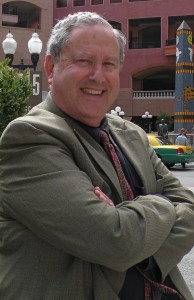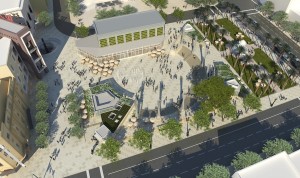Cover Story — December 2012
Rendering of Horton Plaza Park in Downtown San Diego
The Public Realm
The Importance of Public Spaces in Our Neighborhoods
By Michael Stepner

The end of November marked the beginning of construction of a new public plaza in Downtown San Diego. On Nov. 29, demolition of the Robinsons–May department store began. The building, only 27 years old, is to be replaced by a 1.3-acre addition to our historic Horton Plaza.
This and other recent examples point to our recent re-understanding of parks, plazas and open spaces as critical components of our urban environment. The San Diego Union editorialized: “Park improvement is among the most important undertakings now before the city. It should have the cordial co-operation of all.”
The quote is not from a recent U-T San Diego editorial, but one written in 1910 — a call to move forward with the implementation of the 1908 Plan for the region, “San Diego: A Comprehensive Plan for its Improvement,” prepared by landscape architect John Nolen. The plan laid out the first system of parks for our region.
More recently, a column in the San Diego Union-Tribune asked, “What, then, is the measure of a great city or region? Its education systems? Its arts? Its business inventiveness? All of the above, but the most overlooked measure is a city’s dedication to public space.” This appeared in a Nov. 28, 2008, column by local author Richard Louv.
The public realm is once again being understood as a critical element in making cities work for the health and well-being of their citizens. Public health professionals have joined with design professionals and others in recognizing that quality urban design and a well designed public realm are key ingredients for the health and wellness of the community. Richard Louv, in his book, “The Last Child in the Woods,” has given the need for our connection to nature, and the lack of it, a name: “Nature Deficit Disorder.”
There is also a growing awareness that the quality of the public realm is a critical element in quality economic development. People want to be in places where they can feel comfortable and enjoy. These spaces can be parks, plazas, and our canyons and even pleasant sidewalks. And they want these things nearby to where they live and work.
In a recent article in the U-T, Roger Showley reported on a city park survey by the Trust for Public Lands. The survey reported that San Diego ranked first in the percentage of land devoted to parks — 22.8 percent or 40,000 acres. But most of that acreage is open space and habitat preservation, a worthwhile and important achievement, But open space and habitat protection can meet only a small part of community needs.
As Showley wrote, San Diego lost points for not locating parks within walking distance of 75 percent of the population. Our average is 62 percent, We ranked 15th out of the 40 regions surveyed. San Diego offers only 1.75 playgrounds per 10,000 people. The 40 region average is 2.17. San Diego is ranked number 27.
The study pointed out what has been pointed out since Nolen presented his plan to the city in 1908. That while we have done many innovative projects related to the public realm, we have not kept up with the needs of our community.
This is not only about parks, but plazas, sidewalks, streets, school yards. Those places where the public can gather. Richard M. Daley, the former mayor of Chicago, put it this way: “Having a place to relax, play, take part in community events and participate in sports and recreational activities is truly key to an individuals well-being and the overall health of a community.”
I recently returned from an extended stay in Madrid, Spain. I don’t know what the public space ratios are in that city, but no matter where I was in that city, I could see a park, a plaza, a playground, many times more than one —and they were always full of people.
This is not to say that our region is not addressing the needs and not doing innovative projects, but as indicated in the Trust for Public Lands survey, we may not be doing as much as we should to meet our needs.
The addition to Horton Plaza is an example of a very different approach — a park replacing a not-so-old department store in an active, vibrant shopping center. Another example is the recent action by the San Diego City Council to dedicate more than 6,000 acres of open space under the auspices of Sen. Christine Kehoe’s Senate Bill 323, and the advocacy of the Canyonlands Organization. The goal of the Canyonlands group is to connect our canyons to our neighborhoods.
Preservation of our canyons and hillsides is a long-standing and continuing initiative of the region. Perhaps why we do it can best be summed up by the following from the 2006 report by the group San Diego Civic Solutions, “Canyonlands, The Creation of a San Diego Regional Canyonlands Park”: “Our canyons bring us nourishment, maintain our health and ventilate our lives. They are our lungs and bronchial tubes.” And the canyons define our neighborhoods and provide us with nearby nature.
The Trust for Public Lands study does show that we continue to fall short on meeting our needs at the same time we have built some innovative models that others are following and that we need to build on:
Ward Park in Normal Heights at Adams Avenue and I-15
The original plans for the freeway showed this area as a mix of freeway ramps, but instead was built out as a neighborhood park that connected with an adjacent school.
Teralta Park in City Heights
Also on I-15 is Teralta Park , a one-block deck that spans the freeway and has helped knit back together the neighborhood bisected by the freeway. It is unfortunate that only one block of the three blocks committed to was built —but it is not too late. Similar decks are proposed over I-5 Downtown to reconnect Centre City with Golden Hill and Uptown.
In 1927, John Nolen, in the updated Comprehensive Plan for San Diego again noted the lack of parks and public space in San Diego. He proposed that all schools and other public buildings should also be the location of parks and playgrounds. And this model has been followed with the joint school park program in San Diego. After school is out the school grounds are opened to the community.
In 1930, the San Diego Union asked City Planning Engineer Glenn Rick what he thought San Diego would be like in 1950. Rick wondered, “Will the park system of the city be extended into densely populated areas?” He responded that “the park system of the city may be enlarged at least by the purchase of small areas in the more densely built-up districts and the landscaping of these areas into neighborhood parks.”
This is an on-going effort.
And we are also heeding both Nolen’s and Rick’s advice that the size of a park is not nearly as important as the quality of its design and its accessibility to the people in the community. The pocket parks in the community of Del Sur and the West Lewis street pocket park in Mission Hills are but two recent examples of this.
But we do have a way to go. There are many opportunities and many needs. This summer the San Diego Architectural Foundation sponsored an exhibit, “We Heart Parks, Making the case for Public Space.” The exhibit contrasted the major park and open space projects we are undertaking — the bayfront, Balboa Park, etc. — with similar projects in other cities and asked the public for their comments. Overwhelmingly, responders felt that while they felt good about our efforts we could and should go farther with what we are doing.
How can we follow the examples of other cities? Are we willing to give up two or three parking spaces in our commercial areas and create “parklets”? Can we install more roundabouts on major streets as was done on La Jolla Boulevard in Bird Rock — and in doing so calm traffic, improve the pedestrian experience and replace asphalt with landscaping?
We have a way to go and lots of opportunity on many scales. How do we insert small parks, playgrounds and plazas throughout the city? What are the right uses for our bayfront? Can we expand Balboa Park into Switzer and Maple Canyons? Can we create our homegrown version of the New York City Highline by turning Park Boulevard from The north end of Balboa Park to the bay into a real boulevard? And can we follow up on the San Diego City Council action in 1937 to re-name Harbor Drive to the John Nolen Parkway and carry that name to Park Boulevard as well?
And how to we educate ourselves that the cost of building and maintaining the public realm is value added for the community and a miniscule investment with great return?
To bring this all together, a quote from Enrique Penalosa, the former mayor of Bogata Columbia: “The importance of pedestrian public spaces cannot be measured. We cannot prove mathematically that wider sidewalks, pedestrian streets, more or better parks make people happier, much less measure how much happier. However, if we reflect, most things that are important in life cannot be measured either…Parks and other pedestrian places are essential to a city’s happiness.”
Michael Stepner 2.JPG
Michael Stepner is a professor at NewSchool of Architecture and Design and the former city architect of San Diego.



